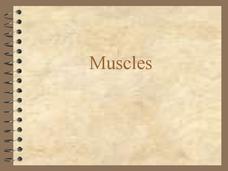Curated OER
Muscles
A compact notebook of slides, this presentation describes characteristics of three types of muscle. Most of the slides consist simply of bullet-point facts for each type, although a diagram and information on the structure of skeletal...
Curated OER
Muscles and Motor Locomotion
This is a fabulous presentation which should reinforce all aspects of muscle construction on a gross anatomical and micro level. There are slides to help understanding with the muscle fiber anatomy, and many labelled diagrams to explain...
Curated OER
Muscle Tissue
For this muscle tissue worksheet, high schoolers match 10 terms with their definitions, answer 12 multiple choice questions, fill in 25 blanks with the appropriate terms and answer 4 questions about topics related to muscle tissue....
Curated OER
The Animal Body and How it Moves
Spark interest in the body structure of vertebrates with this comprehensive and colorful worksheet. Your biology class will explore the levels of organization, primary tissue types, and the main organ systems. Finally, they hone in on...
Curated OER
Muscles
In this muscles worksheet, learners describe characteristics of the three types of muscle and the function of each. Then they describe the gross and microscopic anatomy of skeletal muscle. Students also describe the steps that occur in a...
Curated OER
21st Century Medicine: Nerves of Steel
Students model a sarcomere's action, they gain a kinesthetic and visual understanding of muscle contraction. They use this exercise stimulates the production of myosin and actin. Students use two colors of clay, make a "sandwich" of...
Curated OER
Protection, Support, and Locomotion
In this human body worksheet, students will review 5 terms associated with the skin by filling in the blank. Then students will read 14 statements about the human skeleton and muscles and determine if its true or false.








